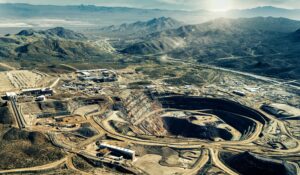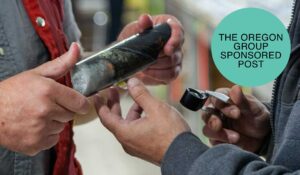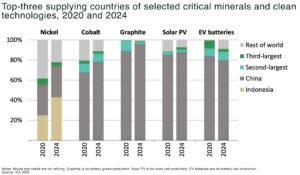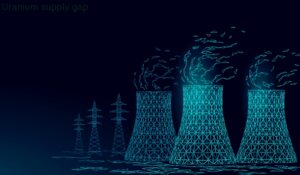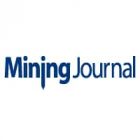EPISODE 8. Anthony Milewski and Christian Purefoy are joined by special guests Mike Stier, CEO of Saga Metals (TSXV: SAGA | OTCQB SAGMF) and Michael Garagan, Geologist of Saga Metals, to talk about the importance of titanium, especially in national security, and their titanium-vanadium project in Canada.
Subscribe for Investment Insights. Stay Ahead.
Investment market and industry insights delivered to you in real-time.
🎙️ Transcript
Conversation between Christian Purefoy, Anthony Milewski, Mike Stier (CEO, Saga Metals), and Michael Garagan (Chief Geologist, Saga Metals). Edited for clarity and readability.
Anthony Milewski: All right, great, everyone.
Mike Stier: Welcome to Boom, Bust and BS with Anthony Milewski and me, Christian Purefoy.
Michael Garagan: And today, we’ve got two special guests to talk about titanium.
Christian Purefoy: Not just titanium,
Anthony Milewski: we’re going to talk about exploration in Canada and and national security, right.
Mike Stier: It’s always interesting.
Michael Garagan: Hey, guys. I appreciate you guys coming on.
Christian Purefoy: Why don’t you just talk in real quick who you are and who you guys are with?
Anthony Milewski: Yeah, sounds good. I’ll start.
Mike Stier: So my name is Mike Stier.
Michael Garagan: I’m the CEO and Director of Saga Metals Corp.
Christian Purefoy: And Michael Garagan, the geologist for Saga.
Anthony Milewski: And yeah,
Mike Stier: I see.
Michael Garagan: I’ve kind of had a look at your website.
Christian Purefoy: Yeah, Saga has a few different projects, but my understanding is
Anthony Milewski: you guys are focused on the titanium part of the exploration portfolio.
Mike Stier: But what exactly is titanium?
Michael Garagan: I mean, when I think about titanium, it’s like,
Christian Purefoy: you know, like someone broke their arm or something.
Anthony Milewski: They’ve got like a titanium bone in there.
Mike Stier: But what actually is titanium for?
Michael Garagan: Yeah, I think that’s a good point, is that it’s you’re right it’s used implants.
Christian Purefoy: If you need, so I’ve got an implant
Anthony Milewski: my old hockey injury I have an implant for my front tooth.
Mike Stier: Right.
Michael Garagan: And it’s titanium based and so it’s really used in so many facets
Christian Purefoy: of our everyday lives that I don’t think we’ve fully grasped it right.
Anthony Milewski: At the end of the day, it’s in your iPhone.
Mike Stier: It’s, it’s on your walls, right?
Michael Garagan: It’s a pigment in paint.
Christian Purefoy: Where does it come from? Right now if I go in and I get something done or whatever,
Anthony Milewski: where is titanium produced today?
Mike Stier: So the majority is it comes out of China.
Michael Garagan: Right.
Christian Purefoy: And so, you know,
Anthony Milewski: when you mentioned at the beginning of this
Mike Stier: the whole national security side
Michael Garagan: of things, over 60% of the world’s titanium comes out of China.
Christian Purefoy: And so that’s that’s kind of the hot topic.
Anthony Milewski: And big issue right now is that…
Mike Stier: Is it mined in China?
Michael Garagan: So the deposits – is a lot in Africa, too?
Christian Purefoy: Or is that something different?
Anthony Milewski: Minerals, you know, titanium.
Mike Stier: Yeah.
Michael Garagan: There’s something that comes out of Africa as well.
Christian Purefoy: Russia, some comes out of Canada right now from Rio Tinto.
Anthony Milewski: Right?
Mike Stier: So it does come from all over the world, but it just it’s dominated by China.
Michael Garagan: And so America is it’s safe to say that
Christian Purefoy: most of America’s titanium is coming from China.
Anthony Milewski: Is that fair?
Mike Stier: I think that’s a fair statement.
Michael Garagan: And again, to come back to the national security side of things,
Christian Purefoy: United States is one of the largest manufacturers of titanium metal.
Anthony Milewski: So like your end use products that, you know, companies
Mike Stier: like Boeing or Airbus or Lockheed Martin would use,
Michael Garagan: but they don’t mine
Christian Purefoy: really any titanium like they import
Anthony Milewski: the majority of their full consumption.
Mike Stier: Is titanium on any of the – I know in recent months there’s been
Michael Garagan: these sanction lists and critical minerals lists and all that sort of stuff.
Christian Purefoy: Do you know, in terms of America, is it on any of those lists?
Anthony Milewski: Absolutely. 100%.
Mike Stier: So has China put tariffs on titanium?
Michael Garagan: Not at
Christian Purefoy: this point in time, but it has come up recently as a threat
Anthony Milewski: of one potential metal that they would not even just tariff
Mike Stier: but potentially cut off the exportation of it to other countries.
Michael Garagan: And I mean, it’s being used on fighter jets in America, right?
Christian Purefoy: This is this is literally national defense fighter jets are made out of this stuff.
Anthony Milewski: All the drones do.
Mike Stier: They use titanium in drones?
Michael Garagan: Yeah,
Christian Purefoy: it’s used in aerospace applications.
Anthony Milewski: So it certainly can be a I haven’t specifically looked up drones,
Mike Stier: but it’s in airplanes, satellites, spaceships, fighter jets.
Michael Garagan: Lockheed Martin’s F-35 Raptor uses 40%
Christian Purefoy: structural titanium and there’s no replacement for titanium.
Anthony Milewski: You said Raptor. I was thinking about the Ford Raptor.
Mike Stier: I wonder. I wonder if there’s titanium in cars.
Michael Garagan: Do they put, there must be titanium in automobiles as well, right?
Christian Purefoy: Automotive. Yep.
Anthony Milewski: There are.
Mike Stier: There are applications as well.
Michael Garagan: Chemical processing.
Christian Purefoy: Do either of you guys golf?
Anthony Milewski: Right. It’s in your it’s in your time.
Mike Stier: Well, it’s yeah, well, it’s in your it’s in your golf clubs.
Michael Garagan: It’s also in tennis rackets.
Christian Purefoy: So titanium is kind of like
Anthony Milewski: a lot of these, you know, Christian, we’re always talking about minor metals
Mike Stier: and critical minerals, and it kind of it’s in the same category.
Michael Garagan: So it’s sort of the same setup.
Christian Purefoy: You know, it’s critical to all these military applications,
Anthony Milewski: uses a bunch of stuff we don’t even know.
Mike Stier: It’s being used in our golf clubs.
Michael Garagan: And there’s always one problem.
Christian Purefoy: China controls it, it’s back to China.
Anthony Milewski: So, you guys, I guess what’s interesting, Mike,
Mike Stier: you guys have a company, it’s listed on the TSX, right?
Michael Garagan: The TSX Venture,. And that and you’ve
Christian Purefoy: got an asset in Canada and you guys tell me a little bit where are you are.
Anthony Milewski: You guys have drilled, I know, quite a bit.
Mike Stier: And what’s the size of your titanium deposit today?
Michael Garagan: And like how does that fit in around like other global deposits
Christian Purefoy: and that sort of thing.
Anthony Milewski: Yeah.
Mike Stier: Like if you want to jump in.
Michael Garagan: Yeah, you bet.
Christian Purefoy: So yeah, we have done are maiden drill program.
Anthony Milewski: I’ll probably like correct you a little bit, is we haven’t done a ton of drilling
Mike Stier: but we, we are pretty advanced within the project.
Michael Garagan: It’s and this kind of comes back to a big discussion within the junior
Christian Purefoy: mining industry in Canada
Anthony Milewski: and the critical minerals and everything that we’re looking for.
Mike Stier: Canada, North America has a ton of these, but for a long time
Michael Garagan: Canadian companies have looked elsewhere around the world.
Christian Purefoy: So there is you know, this is kind of a perfect example
Anthony Milewski: is this titanium vanadium deposit that we’re looking at…
Mike Stier: Sorry to interrupt you,
Michael Garagan: we literally just published on vanadium. You did,
Christian Purefoy: yeah, absolutely.
Anthony Milewski: And I read that article and it was I honestly thought it was a brilliant
Mike Stier: article.
Michael Garagan: And titanium vanadium, in my opinion, go hand in hand.
Christian Purefoy: They are quite often found in not only the same deposits,
Anthony Milewski: but often the same minerals as is the case with our project is
Mike Stier: we are getting titanium and vanadium locked up in titanium magnetite.
Michael Garagan: So when I hear magnetite and
Christian Purefoy: I’m not a geologist, I just play one TV, I think about iron ore.
Anthony Milewski: It is there is, there
Mike Stier: is a relationship between your deposit and iron ore.
Michael Garagan: Absolutely.
Christian Purefoy: You’re absolutely right there. Yeah.
Anthony Milewski: Okay.
Mike Stier: So you’re saying that Canada and North America have got a lot of these minerals,
Michael Garagan: but there’s been this problem they have in mind, is that correct?
Christian Purefoy: So yeah, and it’s kind of an interesting discussion.
Anthony Milewski: And you know what Russia and China has done really good at is going at these
Mike Stier: really large tonnage,
Michael Garagan: layered mafic intrusions, big, big deposits of titanium.
Christian Purefoy: I got to hold you right there.
Anthony Milewski: You lost me at layered
Mike Stier: Well, what what is the.
Michael Garagan: I don’t even know you’re talking about. You got to help us out.
Christian Purefoy: It’s a layered, mafic intrusion, intrusion, layered mafic intrusion.
Anthony Milewski: And that didn’t mean to get too technical, but point is, they’re very big,
Mike Stier: very large deposits. And what you’re saying
Michael Garagan: is your style of deposit sitting in North America and Canada
Christian Purefoy: potentially the
Anthony Milewski: 51st state we’ve heard, although it’s not been confirmed,
Mike Stier: has this big
Michael Garagan: ore body or this big anomaly, is it an anomaly right now?
Christian Purefoy: And you guys are basically going out and you have a drilling program lined up.
Anthony Milewski: What do you guys have going on?
Mike Stier: Yeah, absolutely.
Michael Garagan: So we’ve started to find the shape of of the anomalies in the ore body.
Christian Purefoy: And we’re continuing to do the drilling
Anthony Milewski: to essentially try and prove how big this thing actually is.
Mike Stier: And it very well could be massive.
Michael Garagan: And that’s what we’re hoping to prove to the markets.
Christian Purefoy: How much are you guys drilling, how many meters do you guys have scheduled?
Anthony Milewski: So the next drill program we’re looking at doing about 10,000 meters.
Mike Stier: That’s going to hit our main targets that will allow us to infer
Michael Garagan: the 20 kilometer trend that we believe is mineralized.
Christian Purefoy: So right now, there’s not an inferred resource on the property.
Anthony Milewski: It’s just you guys are kind of kicking off the drilling program to create one,
Mike Stier: is that right?
Michael Garagan: Absolutely. That’s correct. Yep.
Christian Purefoy: And remind us what who else produces titanium in Canada?
Anthony Milewski: Does anyone Rio?
Mike Stier: Maybe Rio Tinto at the mine
Michael Garagan: Lac Tio in southeastern Quebec.
Christian Purefoy: They, as far as I know, are the only big time producers
Anthony Milewski: of titanium coming really out of North America outside of your ilmenite sands.
Mike Stier: There’s this this one
Michael Garagan: in America, right in Utah or something, I thought.
Christian Purefoy: But they’re very well like there’s I know
Anthony Milewski: if you follow the Appalachians down there like I think Tennessee has one
Mike Stier: there’s ilmenite sand deposits and they’re pretty rich in titanium.
Michael Garagan: The problem with those deposits is because they’re like
Christian Purefoy: a sedimentary sand, essentially a plaster deposit.
Anthony Milewski: Quite often they’re not that big.
Mike Stier: And, you know,
Michael Garagan: that’s the that’s been the big difference between, say, China and Russia.
Christian Purefoy: And what the Western nations have done is we’ve looked at these plaster deposits,
Anthony Milewski: If you will, as as being easy and cheap to mine, where Russia and China has looked
Mike Stier: at these great big deposits that, yes, might take more capital to get it going,
Michael Garagan: but they might have 75, 150 year mine life.
Christian Purefoy: And a deposit like you guys
Anthony Milewski: And I know it’s early,
Mike Stier: but what order of magnitude of CapEx is something like this going to require?
Michael Garagan: Is it
Christian Purefoy: is that in the low hundreds of millions or I mean, I don’t like it, who knows?
Anthony Milewski: But it seems like it’s hard to raise $1,000,000,000 today.
Mike Stier: Right? I mean, it’s challenging.
Michael Garagan: Yeah.
Christian Purefoy: I mean, I think for us and again,
Anthony Milewski: like we brought on Paul McGuigan, he’s an expert, geologist and metallurgist,
Mike Stier: and he’s confirmed in the zone that we’ve drilled
Michael Garagan: that we do have simplified metallurgy, right.
Christian Purefoy: So because we only have the one mineral magnetite
Anthony Milewski: that we can essentially do a crush and magnetic separation of the mineral,
Mike Stier: pulling out the combination of iron, titanium and vanadium
Michael Garagan: ore body essentially, and then ship that off for processing.
Christian Purefoy: So our we would endeavor to keep, you know,
Anthony Milewski: any kind of plant or CapEx to a minimum at our actual site
Mike Stier: because there’s already other facilities around the world like in Quebec
Michael Garagan: that already processes titanium, iron, vanadium, those kinds of things.
Christian Purefoy: Would you guys,
Anthony Milewski: would you also be producing
Mike Stier: vanadium and iron ore?
Michael Garagan: Correct? Yes.
Christian Purefoy: Yeah, it’s it’s all it’s all byproducts from the same processing methodology.
Anthony Milewski: Interesting.
Mike Stier: Yeah. Okay. So what’s the next steps?
Michael Garagan: The next step is you guys, over the summer, you’re going to be drilling.
Christian Purefoy: You’re probably already out there.
Anthony Milewski: Are you going to be out there?
Mike Stier: And. Yeah, I’ll be out there in the next week actually.
Michael Garagan: Cool, and then help us out.
Christian Purefoy: So how long from when you start drilling until you can start typically
Anthony Milewski: announcing how those drillers thoughts are going as
Mike Stier: is it take a few months, a few weeks, six months.
Michael Garagan: So I mean, yeah, go for it.
Christian Purefoy: So really what you’re waiting for is your assays from the laboratory, right?
Anthony Milewski: So you’re pulling the drill core up,
Mike Stier: you’re doing your descriptions, you’re taking your samples.
Michael Garagan: Those samples have to go to the laboratory and you need that.
Christian Purefoy: That kind of verified laboratory confirmation of what
Anthony Milewski: is in that rock to be able to actually release that to the public.
Mike Stier: We can we can talk about things and update the public
Michael Garagan: in the markets and the investors on how the progress is going.
Christian Purefoy: But not until you have those concrete laboratory results,
Anthony Milewski: can we speak to that.
Mike Stier: And is it getting busy with gold being where it’s at?
Michael Garagan: Is there a lot?
Christian Purefoy: I mean, is that
Anthony Milewski: are you feeling like more pressure at the labs
Mike Stier: just because of all the activity that’s going on up there?
Michael Garagan: Not not really a factor, I think here.
Christian Purefoy: I mean, we we’ve got a good relationship with the lab
Anthony Milewski: and they’ve I would actually say the last drills results
Mike Stier: we got on our first maiden program like they were
Michael Garagan: we didn’t have to overpay for rushed
Christian Purefoy: assays and they came back in a respectable time
Anthony Milewski: period consistent with a lot of our other programs that were just grab
Mike Stier: sample programs like it all came back fairly in good order.
Michael Garagan: So I’m not expecting any unknown delays or unforeseen delays
Christian Purefoy: with other commodities. Interesting.
Anthony Milewski: So what’s changed then in North America to make this viable
Mike Stier: from what’s gone through the last couple of decades to what’s happening now.
Michael Garagan: Geopolitics, for one,
Christian Purefoy: the geopolitical atmosphere,
Anthony Milewski: but also the research that has gone into the metallurgy
Mike Stier: and the recovery of titanium and vanadium from things like magnetite.
Michael Garagan: That’s again, one of the reasons that North America
Christian Purefoy: has looked at these small ilmenite sand projects as being so viable.
Anthony Milewski: There is less complications now.
Mike Stier: But we’ve actually, you know, and in China’s
Michael Garagan: led some of the headway with the research on the recovery,
Christian Purefoy: it’s potentially a massive turning point
Anthony Milewski: where these big deposits
Mike Stier: are potentially even more viable,
Michael Garagan: more economically viable than they’ve ever been before.
Christian Purefoy: I’ve had people reference that it’s kind of on
Anthony Milewski: and again, not to get technical but on the verge of when we worked out
Mike Stier: the models and the research for copper porphyry deposits
Michael Garagan: that changed the copper industry for forever like globally
Christian Purefoy: and it kind of feels like we’re on the verge of that. But
Anthony Milewski: so what’s next steps here?
Mike Stier: I mean, it seems like for the market just updating on this joint program
Michael Garagan: is going to be really, really key to kind of
Christian Purefoy: just everything it sounds like from my perspective.
Anthony Milewski: I mean, in addition to the geopolitical environment
Mike Stier: which you don’t control, I mean, that’s just as what it is.
Michael Garagan: But it seems like there’s drilling programs pretty critical.
Christian Purefoy: Yeah, for sure.
Anthony Milewski: And just the back up, you know, one second.
Mike Stier: I think one important factor here is that our the maiden drone program
Michael Garagan: that we did sort of confirmed the thesis
Christian Purefoy: that not only does this magnetite sit below the surface,
Anthony Milewski: but it is quite extensive, extensive,
Mike Stier: and has the ability to be quite, you know, large across the entire property.
Michael Garagan: And so this is utilizing a combination of grab samples, geophysics,
Christian Purefoy: which is essentially utilizing a magnetometer
Anthony Milewski: which detects the magnetic levels coming from underneath the surface,
Mike Stier: and then using that to to drill essentially.
Michael Garagan: So all of that combined is what got us to where we are right now.
Christian Purefoy: That has confirmed this 500 meter zone that is quite extensive.
Anthony Milewski: Just within this small zone, we have 19 and a half more kilometers
Mike Stier: at minimum to go drill with
Michael Garagan: about four immediate priority targets that this summer we’re going to be doing
Christian Purefoy: that same geophysics on to get that same below the surface
Anthony Milewski: 3D, you know,
Mike Stier: image, an anomaly that you can see so that Mike can take that to delineate,
Michael Garagan: you know, exactly where do we want to put the drills and then we’re going
Christian Purefoy: to move that along the property along the remaining 19 and a half kilometers.
Anthony Milewski: So again, this is where when you compare it to other projects,
Mike Stier: this 20 kilometer
Michael Garagan: inferred zone is unbelievable.
Christian Purefoy: That’s pretty cool.
Anthony Milewski: So just for the people who are not
Mike Stier: mining engineers or even you know, that close to the industry.
Michael Garagan: I mean, 20 kilometers.
Christian Purefoy: I’m just thinking about how long that is.
Anthony Milewski: You know, I can’t go jog 20 kilometers, let’s put it that way.
Mike Stier: I mean, probably more like 5, but
Michael Garagan: do you have to put the roads in that
Christian Purefoy: get a drilling spot or is it kind of open, is it forested?
Anthony Milewski: How hard is it to actually get out there and drill this thing?
Mike Stier: So that’s a great, great point.
Michael Garagan: Mike, if you don’t mind, I kind of step in. There is
Christian Purefoy: one of the
Anthony Milewski: amazing things about this property is we are ten kilometers from the coastal
Mike Stier: town of Cartwright, Cartwright, Labrador,
Michael Garagan: so we have unbelievable infrastructure.
Christian Purefoy: Like we have a road that literally takes us
Anthony Milewski: about 100 meters from our main mineralized zone.
Mike Stier: So in other projects where you’re expecting heavily
Michael Garagan: forested areas and you’re punching big roads and yes,
Christian Purefoy: we are putting roads in to get the drill exactly to where we want it,
Anthony Milewski: but that’s a matter of a kilometer or two or a mile or two
Mike Stier: or a couple hundred meters rather than ten, 15, 20 kilometers.
Michael Garagan: So that is a huge difference and an advantage that we have.
Christian Purefoy: Well, and to kind of help people with that,
Anthony Milewski: when we say we’re going to put a road in from, say,
Mike Stier: one of the already existing access roads that would come into the property
Michael Garagan: where you would actually drill,
Christian Purefoy: we’re not we’re not talking about your typical road,
Anthony Milewski: you know, in your neighborhood, Like we’re not paving this thing
Mike Stier: or it doesn’t require a whole, you know, extensive amount of work to do it.
Michael Garagan: We’re talking about using an excavator to just create a proper,
Christian Purefoy: nice smooth surface so that we can move a drill along.
Anthony Milewski: Right.
Mike Stier: So it’s a very simplistic process, doesn’t,
Michael Garagan: you know, cost a whole lot to do it, but it’s going to be game
Christian Purefoy: changing in terms of being able to move that drill along
Anthony Milewski: and just keep going along the whole 10,000 meters that we want to do right.
Mike Stier: It’s exciting.
Michael Garagan: Well, look, I am really glad you guys have come on the show
Christian Purefoy: and talked to us a little bit about titanium.
Anthony Milewski: I’d love to have you guys back when some of your results start coming in.
Mike Stier: Help us understand what the meaning of it is
Michael Garagan: and maybe come back on and give us an update on the market
Christian Purefoy: as things continue to develop inside of the U.S.
Anthony Milewski: And Elon and Trump work out their their the bromance.
Mike Stier: Yeah.
Michael Garagan: So like really appreciate it and thanks a lot for coming in.
Christian Purefoy: Yeah thank for having us on today.
Anthony Milewski: I really appreciate it. Thanks guys.







